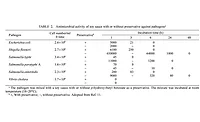Food Safety
Why companies should do internal audits during off hours
Expanding internal audits to different times of day can help strengthen food safety.

The third set of eyes is an extremely valuable asset in food plants. That third set of eyes could be the auditor, a consultant or someone from the corporate offices. Unfortunately, far too many processors look at the third-party audit as a necessary evil and something that they must “pass.”
I have done audits where the first question the company asked was, “What do I need to pass?” These operators are truly unclear on the concept. Audits should be looked at as a means to improve; the third set of eyes should be there helping to identify how to do things better or, in other words, continuous improvement.
The ISO 22000 food safety standard, FSSC 22000 and other GFSO audit schemes, SQF, BRC and IFS, have one unique element in them that all food processors should adopt, that is, the internal audit. An internal audit is defined as, “A systematic evidence gathering process that is carried out to determine how well a food safety management system meets a set of expectations.”
The expectation is that processors will conduct audits of all elements making up the food safety management system. These audits should be done by persons independent of the element being audited.
However, it is a good idea to expand the internal audit program to look at different areas around the plant and conduct these visits at what might be construed as “odd times.” By odd times, I mean during rainstorms, high winds or the night shift.
Third-party auditors rarely come into food plants during night shifts, which really is a mistake, as this is when many conduct cleanup. I have done this a few times accompanied by the staff with whom I was working. Frankly, they were aghast at some of the things that they saw after hours. So, consider making an occasional unannounced visit to see what the cleanup crew or the late shift is doing.
Another good time to walk around your plant and the grounds is during a rainstorm or immediately after a good rain. This will give you the opportunity to confirm (hopefully) that the roofs are in good shape and that there are no leaks. Thinking back, I am really surprised at how many times I have been in plants during rainstorms and seen problems: roof leaks, water intrusion, standing water and others. All of these issues can potentially cause bigger problems.
In fact, it was roof leaks in the Peanut Corporation of America plant that contributed to the Salmonella outbreak associated with its products. And, of course, if rainwater comes through a roof and lands on products, ingredients or packaging, those items would be rendered adulterated and would have to be disposed of.
Standing water is another issue that can create potential problems, especially in ready-to-eat (RTE) products. It is also one of those issues that one can guarantee will show up as an adverse finding on a third-party audit.
Processors whose facilities are located in parts of the world that do not get much rain should take advantage of the wet weather to do a comprehensive walk-around of their plant and grounds. I recently witnessed this in a facility in Northern Arizona, an area not subject to regular rainfalls.
How many people have considered the prevailing winds when they build a plant or make modifications? Winds can blow dirt and other materials into a plant and can compromise air filters and other equipment in a plant.
My major professor from graduate school told me of an experience he had with a Bay Area manufacturer of dry salami products. The company built a new facility and had sporadic problems with finished products—black mold spots on the desired white surface mold.
The problem traced back to how the plant was designed. The prevailing winds were from the west, and the air intakes faced west. High winds ended up blowing wild mold spores into the facility.
The long-term solution was to reposition the direction the intakes faced. The short-term solution was to install a wind sensor on the roof that would close the intakes if air velocity reached a certain point.
The last point is not about weather, but plant design. There are a number of unwritten rules that usually apply in all food plants. One is, “The harder it is to do a task, the less chance it will be done properly.” This is often true during cleanup. If a piece of equipment has to be disassembled and disassembly is difficult, it will often not be done or not be done properly.
Another rule is, “If there is a flat surface in a food plant, something will be stored or placed on that surface.” There is a reason that people recommend that employee lockers have a canted top. Did you ever get up on a ladder and look at all the stuff that ends up on top of flat-topped lockers? Trash, boots, food waste, dirty clothes and other materials.
There are usually lots of flat surfaces in a food plant which tend to become magnets for all kinds of things, many of which have no place in a food processing plant. Flat-topped electrical boxes, flat steel girders, flat supports for tables and other surfaces all attract junk, some of which could pose a product adulteration concern. And once something gets deposited on a surface, it tends to stay there.
So, walk through your plant on a rainy or windy night and look at things as if you have never seen them before. Are you happy with what you see, or do you think you can do better? Be that extra set of eyes.
Looking for a reprint of this article?
From high-res PDFs to custom plaques, order your copy today!




